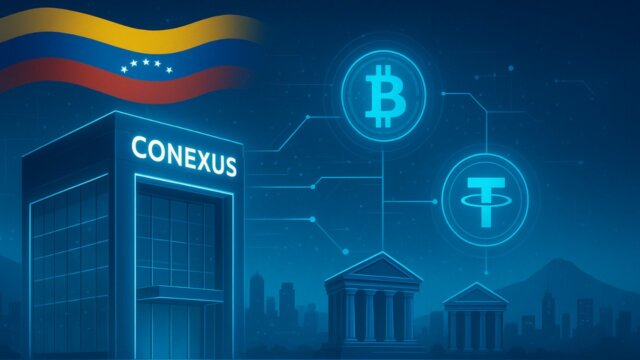- Venezuela is set to integrate digital assets, including Bitcoin (BTC) and stablecoins like Tether (USDT), into its national banking system, potentially becoming the first widespread effort of its kind in Latin America.
- The initiative announced by payment network operator Conexus aims to connect traditional banks with cryptocurrencies, allowing for services including custody, transfer, and exchange by December 2025.
- High inflation, a devalued local currency, and limited access to foreign currency are driving Venezuelans to seek alternative financial solutions, making stablecoins a popular choice for hedging against economic instability.
In a bold move that could redefine how citizens interact with money, Venezuela is gearing up to integrate digital assets into its national banking system. The country’s leading payment network operator, Conexus, has announced a plan to connect traditional banks with cryptocurrencies such as Bitcoin and stablecoins like Tether (USDT). The initiative, if successful, would mark one of the first widespread efforts in Latin America to bridge blockchain-based assets and conventional banking infrastructure.
A leap into digital finance
According to multiple reports, Conexus — which currently processes roughly 40% of Venezuela’s online money transfers — is developing a system that will allow banks to offer services for custody, transfer, and exchange of Bitcoin and stablecoins directly. The goal: by December 2025, some of the nation’s banks could begin letting users buy, sell, store, and move cryptocurrencies and stablecoins through their usual bank accounts.
Why now? A response to economic stress
Venezuela’s macroeconomic environment has long been under strain: high inflation, a severely devalued local currency (the bolívar), and limited access to foreign currency have forced many citizens to seek alternative financial tools.
In this context, stablecoins — digital tokens pegged to stronger assets (especially the U.S. dollar) — and cryptocurrencies have stepped in as survival tools. For many Venezuelans, these digital assets provide a hedge against inflation and volatile currency moves.
By embedding crypto services within the banking system, Conexus and its partners aim to offer a regulated, easier-to-use alternative instead of the “wild west” of unregulated crypto. As Conexus president Rodolfo Gasparri put it: “We’re working on a blockchain project because our currency changes too much. People are using stablecoins to keep their money safe.”
How the system is expected to work
Here’s a rough sketch of how the integration could operate:
- A Venezuelan user opens a bank account or already holds one at a bank participating in the Conexus network.
- Through the bank’s digital interface (or via the interbank blockchain network), the user can access services to buy, hold, send, exchange Bitcoin or USDT.
- The bank, leveraging Conexus’s infrastructure, provides custody of the crypto assets, ensures regulatory oversight, and exchanges between fiat (bolívar or other allowed currency) and crypto.
- The transactions are handled via a blockchain-based interbank system, which Conexus is developing to enable seamless transfers and custody among banks.
- Regulators are expected to be involved, giving users legal protection, clearer oversight, and perhaps lower risk than unregulated peer-to-peer crypto use.
What it means for banks and the broader system
For the banking sector, the move signals a significant shift. Rather than crypto being an external alternative, it becomes part of the mainstream financial infrastructure. By offering crypto services directly, banks can:
- Tap into the rising demand among Venezuelans for digital assets and stablecoins as savings and transaction vehicles.
- Potentially reduce reliance on foreign currency access (a major challenge under sanctions and capital controls).
- Improve transaction speed, transparency, and traceability via blockchain technology.
- Position themselves as more innovative and closer to user needs in a highly unstable currency environment.
For the national economy, this could mean:
- Enhanced financial inclusion: more people might access formal financial services if crypto-enabled banks attract users previously excluded.
- Reduced reliance on informal or black-market exchanges, which often subject users to high fees, risk, and little oversight.
- A pathway to stabilize savings: if crypto assets become widely accepted, citizens might find ways to preserve value without fleeing the formal system entirely.
- However, it also comes with risks: if crypto adoption accelerates too fast without proper regulation, banks could face asset-liability mismatches, regulatory confusion, or exposure to volatile crypto markets.
A potential model for other countries
Industry analysts believe Venezuela’s plan could serve as a template for other nations dealing with similar economic pressures — especially those with high inflation, weak currencies, and significant informal finance sectors.
By embedding crypto and stablecoins within regulated banking rails, a country can offer both the innovation of digital assets and the protections of banking oversight. The result: a hybrid system that leverages blockchain efficiency with institutional trust. Globally, banks and payment firms are increasingly exploring blockchain and tokenization. Venezuela’s initiative may accelerate acceptance of this model in emerging markets.
Venezuela’s plan — spearheaded by Conexus to allow banks to integrate Bitcoin and stablecoins into their everyday services — is ambitious and full of promise. If realized by December 2025, it could reshape how Venezuelans save, pay, and manage their money. It offers a layered solution to persistent economic problems: combining digital-asset innovation with the stability and oversight of the banking system. But success is far from guaranteed. Infrastructural challenges, regulatory uncertainty, education needs, volatility risks and the country’s broader economic context all loom large. Still, if it works, Venezuela could become a blueprint for other nations seeking to modernize banking via blockchain. The world will be watching.
Disclaimer: CryptopianNews shares this for learning and info only. It’s not meant to be financial or investment advice. Crypto markets change a lot and move quickly. Investing in them can be risky. You should always look into things yourself. Talk to a trained financial advisor before making any choices about investing.
- U.S. Crypto ETFs Set for November Boom After SEC Delays - November 2, 2025
- Bitcoin and Stablecoins Coming to Venezuela’s Banks - October 31, 2025
- Crypto Market Reform Moves Forward Despite Shutdown - October 30, 2025

